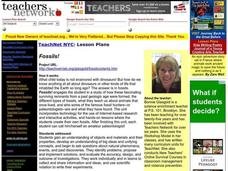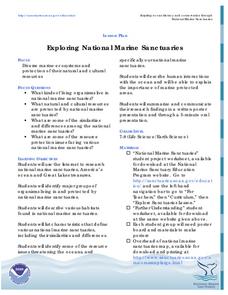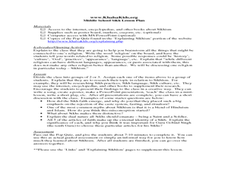Curated OER
Fossils!
Students conduct Internet research about different types of fossils, the animals they are from, and some famous paleontologists. They also participate in some interactive activities and hands-on lessons in which they create their own...
Curated OER
Exploring National Marine Sanctuaries
Students research marine ecosystems by creating class presentations. In this oceanography lesson, students research the different locations of marine sanctuaries by identifying them on a transparency map in class. Students...
Curated OER
Safe or Not Safe
Students discuss the safety signs they viewed on their way to school before looking at safety signs at a website that presents a traffic safety school for students. They listen to a read aloud of Tana Hoban's, "I Read Signs," make signs,...
Curated OER
Survival of the Fittest – Battling Beetles
Students explore natural selection. For this genetic adaptation lesson, students discover why certain traits continue and some traits disappear. Students discover how species evolve and change. Resources are provided.
Curated OER
Ecosystems Online
Students work together to gather information on ecosystems from websites. They identify plants and animals and create their own website. They are graded on their willingness to work together and the content on the website.
Curated OER
"Slice of Pi with Neo-Excel"
Students explore diameter, radius, and circumference. They define radius, diameter, and circumference on an online dictionary, identify objects in the room with a radius and a diameter, and calculate the radius and diameter of various...
Curated OER
Water Quality of Local Lakes
Students research the quality of water in a regional lake of West Bloomfield in the past and present. They compare conditions of the lake, past and present. They then give examples of local and regional human activities that may have had...
Curated OER
The New Canada Project
Students focus on one province/territory in Canada. They study the natural resources, location and geographical significance, physical geography, people, culture, climate, and the brief history.
Curated OER
Fod Pyramid
Sixth graders investigate the Food Pyramid and how it relates to their own diet. They conduct Internet research, complete the "Rate Your Plate" online activity, and create a HyperStudio presentation.
Curated OER
Energy Is Everywhere
Students determine the difference between renewable and non-renewable resources and identify the different forms of energy. They discuss life without energy and where energy comes from before reading an article about the different...
Curated OER
Exploring Virtual Europe
Learners research the geography, government, climate, history, economy, and culture of a European country. They select a country in Europe, explore various websites, and complete a worksheet.
Curated OER
Ship of Gold
Students explore American values. In this American history instructional activity, students read passages from Ship of Gold in the Deep Blue Sea. Students collaborate to conduct research in order to build a timeline of the events...
Curated OER
Then and Now. Public Health from 1900 to Today
Students analyze public health issues. In this public health instructional activity, students research Internet and print sources regarding the health concerns and diseases of the 20th and 21st centuries. Students also interview...
Curated OER
Discriminating Issues
Students examine how U.S. Law Defines Discrimination In this lesson. They research the issues surrounding a variety of types of discrimination, and then write editorials analyzing legal and social positions on discrimination in the...
Curated OER
F is for Fair!
Ninth graders examine their human right to education. In this American Government lesson, 9th graders evaluate how well the world is doing when it comes to providing a free, equal, quality education to our youth.
Curated OER
Smallville Prairie Development Project
Students research the characteristics of the prairie habitat focusing on scientific, social/historical and aesthetic values. They investigate how humans impact the prairie habitat while maintaining a daily journal of research and...
Curated OER
Rainforest Adventures
Young scholars study the vegetation and types of animals that live in the rainforest. They role-play their favorite rainforest animals and write letters from the viewpoint of their favorite animals. After writing their letters, they...
Curated OER
Religion - Sikhism
Middle schoolers investigate Sikhism. In this Sikhism lesson, students research the different aspects of this religion. They work in small groups to research details about Sikh practices, language, and culture. They design a presentation...
Curated OER
Poetry Sings
Students examine examples of literary terms in poetry. Then they choose two songs, write out the lyrics, and decipher what they think the artist is trying to say. Each student presents their song to the class and they cite examples of...
Curated OER
Geography, Map Skills & the Internet:
Middle schoolers research various websites focusing on Italy while enhancing student utilization of computer, keyboards and the Internet. They discuss their findings on the geography, history, topography, and culture.
Curated OER
The Mysteries of Harris Burdick
Fourth graders read and discuss the book, The Mysteries of Harris Burdick. They create an original story that follows the Harris Burdick formula, and illustrate the story in the style of Chris VanAllsberg.
Curated OER
Roman Empire: Physical Framework - Location, Borders, Dimensions
Young scholars relate the classical world to the modern world. In this map skills lesson, students turn a blank map into a colorful complete map by following step-by-step directions. This lesson allows young scholars to connect our...
Curated OER
Pretty Patterns
Students discuss shape and number patterns and play a game practicing completing patterns. Then they rotate through five workstations that reinforce the concept of patterning.
Alabama Learning Exchange
Let's Identify and Classify
Students participate in a creative activity to give them a good understanding of classification. They examine bags of chips and discuss their similarities and differences. Students work in small groups while participating in this activity.

























